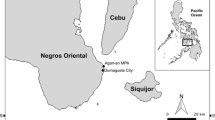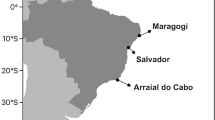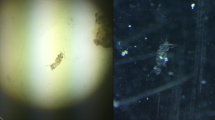Abstract
On coral reefs, gnathiid isopods are a common blood-feeding ectoparasite of reef fishes that can have significant impacts on reef-fish health and fitness. Cleaner fishes and shrimps are the only major documented predators of gnathiids, removing them from the bodies of host fishes. However, gnathiids spend most of their lifecycle free living and thus may be eaten by other microcarnivorous fishes that collectively could have larger impacts on gnathiid populations. This study examined gut contents from Caribbean nocturnal reef microcarnivorous fish and from the Caribbean cleaning goby Elacatinus evelynae for the presence of gnathiid isopods. Among nocturnal microcarnivores, gnathiids were found in only a small proportion of the gut contents of grunts (5%) and cardinalfish (4%), but in a higher proportion of the gut contents of squirrelfish and soldierfish (26%). In comparison, most cleaning gobies collected in the morning had gnathiids (93%), with an average of 6.3 gnathiids per fish. While microcarnivorous fishes ate far fewer gnathiids, they were present in much greater numbers than cleaning gobies. These results support previous studies on cleaning gobies suggesting that individually, they consume high numbers of gnathiids. However, they also suggest that collectively, other predators could have an equal or greater impact on gnathiid populations.



Similar content being viewed by others
References
Abràmoff MD, Magalhães PJ, Ram SJ (2004) Image Processing with ImageJ. Biophotonics International 11:36–42
Anderson RM, May RM (1979) Prevalence of schistosome infections within molluscan populations: observed patterns and theoretical predictions. Parasitology 79:63–94
Arnal C, Côté IM (2000) Diet of broadstripe cleaning gobies on a Barbadian reef. J Fish Biol 57:1075–1082
Artim JM, Sikkel PC (2013) Live coral repels a common reef-fish ectoparasite. Coral Reefs 32:487–494
Artim JM, Sikkel PC (2016) Comparison of sampling methodologies and estimation of population parameters for a temporary fish ectoparasite. Int J Parasitol Parasites Wildl 5:145–157
Artim JM, Sellers JC, Sikkel PC (2015) Micropredation by gnathiid isopods on settlement-stage reef fish in the eastern Caribbean Sea. Bull Mar Sci 91:479–487
Baliga VB, Mehta RS (2014) Scaling patterns inform ontogenetic transitions away from cleaning in Thalassoma wrasses. J Exp Biol 217:3597–3606
Baliga VB, Mehta RS (2015) Linking cranial morphology to prey capture kinematics in three cleaner wrasses: Labroides dimidiatus, Larabicus quadrilineatus, and Thalassoma lutescens. J Morphol 276:1377–1391
Baliga VB, Law CJ (2016) Cleaners among wrasses: phylogenetics and evolutionary patterns of cleaning behavior within Labridae. Mol Phylogenet Evol 94:424–435
Baliga VB, Mehta RS (2016) Ontogenetic allometry in shape and flexibility underlies life history patterns of labrid cleaning behavior. Integr Comp Biol 56:416–427
Barber I, Wright HA (2006) Effects of parasites on fish behavior: interactions with host physiology. In: Balshine S, Sloman KA, Wilson RW (eds) Behaviour and physiology of fish. Academic Press, Cambridge, MA, pp 109–149
Becker JHA, Grutter AS (2004) Cleaner shrimp do clean. Coral Reefs 23:515–520
Beijbom O, Edmunds PJ, Roelfsema C, Smith J, Kline DI, Neal BP, Dunlap MJ, Moriarty V, Fan TY, Tan CJ, Chan S, Treibitz T, Gamst A, Mitchell BG, Kriegman D (2015) Towards automated annotation of benthic survey images: variability of human experts and operational modes of automation. PLoS One 10:e0130312
Cheney KL, Côté IM (2005) Mutualism or parasitism? The variable outcome of cleaning symbioses. Biol Lett 1:162–165
Chin A, De Loma TL, Reytar K, Planes S, Gerhardt K, Clua E, Burke L, Wilkinson C (2011) Status of coral reefs of the Pacific and outlook: 2011. Global Coral Reef Monitoring Network, 260 pp
Coile AM, Sikkel PC (2013) An experimental field test of susceptibility to ectoparasitic gnathiid isopods among Caribbean reef fishes. Parasitology 140:888–896
Côté IM (2000) Evolution and ecology of cleaning symbioses in the sea. Oceanogr Mar Biol Annu Rev 38:311–355
Crofton HD (1971a) A model of host–parasite relationships. Parasitology 63:343–364
Crofton HD (1971b) A quantitative approach to parasitism. Parasitology 62:179–193
Curtis LM, Grutter AS, Smit NJ, Davies AJ (2013) Gnathia aureamaculosa, a likely definitive host of Haemogregarina balistapi and potential vector for Haemogregarina bigemina between fishes of the Great Barrier Reef, Australia. Int J Parasitol 43:361–370
Darcy GH, Maisel E, Ogden JC, Darcy GH, Maisel E, Ogden JC (1974) Cleaning preferences of the gobies Gobiosoma evelynae and G. prochilos and the juvenile wrasse Thalassoma bifasciatum. Copeia 1974:375–379
Davies AJ, Smit NJ, Hayes PM, Seddon AM, Wertheim D (2004) Haemogregarina bigemina (Protozoa: Apicomplexa: Adeleorina)—past, present and future. Folia Parasitol (Praha) 51:99–108
De’ath G, Fabricius KE, Sweatman H, Puotinen M (2012) The 27-year decline of coral cover on the Great Barrier Reef and its causes. Proc Natl Acad Sci U S A 109:17995–17999
Demopoulos AWJ, Sikkel PC (2015) Enhanced understanding of ectoparasite–host trophic linkages on coral reefs through stable isotope analysis. Int J Parasitol Parasites Wildl 4:125–134
Díaz S, Purvis A, Cornelissen JHC, Mace GM, Donoghue MJ, Ewers RM, Jordano P, Pearse WD (2013) Functional traits, the phylogeny of function, and ecosystem service vulnerability. Ecol Evol 3:2958–2975
Farquharson C, Smit NJ, Sikkel PC (2012a) Gnathia marleyi sp. nov. (Crustacea, Isopoda, Gnathiidae) from the eastern Caribbean. Zootaxa 3381:47–61
Farquharson C, Smit NJ, Grutter AS, Davies AJ (2012b) Gnathia masca sp. nov. (Crustacea, Isopoda, Gnathiidae) from Lizard Island, Great Barrier Reef. Australia. Zootaxa 3233:22–36
Grutter AS (1996) Parasite removal rates by the cleaner wrasse Labroides dimidiatus. Mar Ecol Prog Ser 130:61–70
Grutter AS (2001) Parasite infection rather than tactile stimulation is the proximate cause of cleaning behaviour in reef fish. Proc R Soc Lond B Biol Sci 268:1361–1365
Grutter AS (2002) Cleaning symbioses from the parasites’ perspective. Parasitology 124:S65–S81
Grutter AS, Feeney WE (2016) Equivalent cleaning in a juvenile facultative and obligate cleaning wrasse: an insight into the evolution of cleaning in labrids? Coral Reefs 35:991–997
Grutter AS, Pickering JL, McCallum H, McCormick MI (2008) Impact of micropredatory gnathiid isopods on young coral reef fishes. Coral Reefs 27:655–661
Hatcher MJ, Dunn AM (2011) Parasites in ecological communities: from interactions to ecosystems. Cambridge University Press, Cambridge
Hatcher MJ, Dick JTA, Dunn AM (2012) Diverse effects of parasites in ecosystems: linking interdependent processes. Front Ecol Environ 10:186–194
Hayes PM, Smit NJ, Grutter AS, Davies AJ (2011) Unexpected response of a captive blackeye thicklip, Hemigymnus melapterus (Bloch), from Lizard Island, Australia, exposed to juvenile isopods Gnathia aureamaculosa Ferreira & Smit. J Fish Dis 34:563–566
Johnson PTJ, Dobson AP, Lafferty KD, Marcogliese DJ, Memmott J, Orlofske SA, Poulin R, Thieltges DW (2010) When parasites become prey: ecological and epidemiological significance of eating parasites. Trends Ecol Evol 25:362–371
Jones CM, Grutter AS (2005) Parasitic isopods (Gnathia sp.) reduce haematocrit in captive blackeye thicklip (Labridae) on the Great Barrier Reef. J Fish Biol 66:860–864
Jones CM, Grutter AS (2007) Variation in emergence of parasitic and predatory isopods among habitats at Lizard Island, Great Barrier Reef. Mar Biol 150:919–927
Jones CM, Nagel L, Hughes GL, Cribb TH, Grutter AS (2007) Host specificity of two species of Gnathia (Isopoda) determined by DNA sequencing blood meals. Int J Parasitol 37:927–935
Kleiber M (1932) Body size and metabolism. Hilgardia 6:315–353
Lafferty KD, Allesina S, Arim M, Briggs CJ, De Leo G, Dobson AP, Dunne JA, Johnson PTJ, Kuris AM, Marcogliese DJ, Martinez ND, Memmott J, Marquet PA, McLaughlin JP, Mordecai EA, Pascual M, Poulin R, Thieltges DW (2008) Parasites in food webs: the ultimate missing links. Ecol Lett 11:533–546
Lazaridis E (2014) lunar: lunar phase and distance, seasons and other environmental factors. https://rdrr.io/cran/lunar/
Losey GS (1974) Cleaning symbiosis in Puerto Rico with comparison to the tropical Pacific. Copeia 1974:960–970
Madin JS, Hoogenboom MO, Connolly SR, Darling ES, Falster DS, Huang D, Keith SA, Mizerek T, Pandolfi JM, Putnam HM, Baird AH (2016) A trait-based approach to advance coral reef science. Trends Ecol Evol 31:419–428
Marks KW, Klomp KD (2003) Appendix two: fish biomass conversion equations. Atoll Res Bull 496:625–628
Marnane MJ, Bellwood DR (2002) Diet and nocturnal foraging in cardinalfishes (Apogonidae) at One Tree Reef, Great Barrier Reef, Australia. Mar Ecol Prog Ser 231:261–268
McGill BJ, Enquist BJ, Weiher E, Westoby M (2006) Rebuilding community ecology from functional traits. Trends Ecol Evol 21:178–185
Nagel L, Grutter AS (2007) Host preference and specialisation in Gnathia sp., a common parasitic isopod of coral reef fishes. J Fish Biol 70:497–508
Nagy KA (2005) Field metabolic rate and body size. J Exp Biol 208:1621–1625
Pandolfi JM, Bradbury RH, Sala E, Hughes TP, Bjorndal KA, Cooke RG, McArdle D, McClenachan L, Newman MJH, Paredes G, Warner RR, Jackson JBC (2003) Global trajectories of the long-term decline of coral reef ecosystems. Science 301:955–958
Penfold R, Grutter AS, Kuris AM, McCormick M, Jones CM (2008) Interactions between juvenile marine fish and gnathiid isopods: predation versus micropredation. Mar Ecol Prog Ser 357:111–119
Poore GCB, Bruce NL (2012) Global diversity of marine isopods (except Asellota and crustacean symbionts). PLoS One 7:e43529
Quattrini AM, Demopoulos AWJ (2016) Ectoparasitism on deep-sea fishes in the western North Atlantic: in situ observations from ROV surveys. Int J Parasitol Parasites Wildl 5:217–228
Randall JE (1967) Food habits of reef fishes of the West Indies. Studies in Tropical Oceanography 5:665–857
Reed KD, Meece JK, Henkel JS, Shukla SK (2003) Birds, migration and emerging zoonoses: West Nile virus, Lyme disease, influenza A and enteropathogens. Clin Med Res 1:5–12
Sebens KP (1977) Autotrophic and heterotrophic nutrition of coral reef zoanthids. Proc 3rd Int Coral Reef Symp 1:397–404
Sikkel PC, Cheney KL, Côté IM (2004) In situ evidence for ectoparasites as a proximate cause of cleaning interactions in reef fish. Anim Behav 68:241–247
Sikkel PC, Herzlieb S, Kramer D (2005) Compensatory cleaner-seeking behavior following spawning in female yellowtail damselfish. Mar Ecol Prog Ser 296:1–11
Sikkel PC, Schaumburg CS, Mathenia JK (2006) Diel infestation dynamics of gnathiid isopod larvae parasitic on Caribbean reef fish. Coral Reefs 25:683–689
Sikkel PC, Ziemba RE, Sears WT, Wheeler JC (2009) Diel ontogenetic shift in parasitic activity in a gnathiid isopod on Caribbean coral reefs. Coral Reefs 28:489–495
Sikkel PC, Welicky RL, Artim JM, McCammon AM, Sellers JC, Coile AM, Jenkins WG (2017) Nocturnal migration reduces exposure to micropredation in a coral reef fish. Bull Mar Sci 93:475–489
Smit NJ, Basson L (2002) Gnathia pantherina sp. n. (Crustacea: Isopoda: Gnathiidae), a temporary ectoparasite of some elasmobranch species from southern Africa. Folia Parasitol (Praha) 49:137–151
Smit NJ, Davies AJ (2004) The curious life-style of the parasitic stages of gnathiid isopods. Adv Parasitol 58:289–391
Soares MC, Côté IM, Cardoso SC, Bshary R (2008) The cleaning goby mutualism: a system without punishment, partner switching or tactile stimulation. J Zool 276:306–312
Sun D, Blomberg SP, Cribb TH, McCormick MI, Grutter AS (2012) The effects of parasites on early life stages of a damselfish. Coral Reefs 31:1065–1075
Tanaka K (2007) Life history of gnathiid isopods—current knowledge and future directions. Plankton and Benthos Research 2:1–11
Thieltges DW, Poulin R (2008) Parasites and pathogens: avoidance. eLS. doi:10.1002/9780470015902.a0003661
Vaughan DB, Grutter AS, Costello MJ, Hutson KS (2016) Cleaner fishes and shrimp diversity and a re-evaluation of cleaning symbioses. Fish Fish 18:698–716
Waters DS, Kwak TJ, Arnott JB, Pine WEI (2004) Evaluation of stomach tubes and gastric lavage for sampling diets from blue catfish and flathead catfish. North Am J Fish Manag 24:258–261
Watson MJ (2013) What drives population-level effects of parasites? Meta-analysis meets life history. Int J Parasitol Parasites Wildl 2:190–196
Weldon PJ, Carroll JF (2006) Vertebrate chemical defense: secreted and topically acquired deterrents of arthropods. In: Debboun M, Frances SP, Strickman D (eds) Insect repellents: principles, methods, and uses. CRC Press, Boca Raton, pp 47–76
White JW, Grigsby CJ, Warner RR (2007) Cleaning behavior is riskier and less profitable than an alternative strategy for a facultative cleaner fish. Coral Reefs 26:87–94
Whiteman EA, Côté IM (2002) Cleaning activity of two Caribbean cleaning gobies: intra- and interspecific comparisons. J Fish Biol 60:1443–1458
Whiteman EA, Côté IM (2004) Individual differences in microhabitat use in a Caribbean cleaning goby: a buffer effect in a marine species? J Anim Ecol 73:831–840
Wilson GDF, Sims CA, Grutter AS (2011) Toward a taxonomy of the Gnathiidae (Isopoda) using juveniles: the external anatomy of Gnathia aureamaculosa zuphea stages using scanning electron microscopy. J Crustac Biol 31:509–522
Wilson SK, Bellwood DR, Choat JH, Furnas MJ (2003) Detritus in the epilithic algal matrix and its use by coral reef fishes. Oceanogr Mar Biol Annu Rev 41:279–309
Acknowledgements
We thank the staff of the MacLean Marine Science Center of the University of the Virgin Islands and of the Virgin Islands Environmental Resource Station (VIERS). We thank the Falconwood Corporation and Staff of the Guana Island Resort. We also wish to thank C. Belyea, E. Brill, J. Buford, V. Davis, A. Elsishans, G. Hendrick, A. McCammon, M. Nicholson, S. Richter, S. Robles, T. Santos, J. Sellers, A. Simons, C. Spitzer, J. Wagner, and R. Welicky for invaluable support in the field. This work was funded in part by grants from the US National Science Foundation (OCE-121615 and OCE-1536794, PC Sikkel, PI). This is contribution number 179 from the University of the Virgin Islands Center for Marine and Environmental Studies.
Author information
Authors and Affiliations
Corresponding author
Additional information
Communicated by Biology Editor Dr. Andrew Hoey
Electronic supplementary material
Below is the link to the electronic supplementary material.
Rights and permissions
About this article
Cite this article
Artim, J.M., Hook, A., Grippo, R.S. et al. Predation on parasitic gnathiid isopods on coral reefs: a comparison of Caribbean cleaning gobies with non-cleaning microcarnivores. Coral Reefs 36, 1213–1223 (2017). https://doi.org/10.1007/s00338-017-1613-6
Received:
Accepted:
Published:
Issue Date:
DOI: https://doi.org/10.1007/s00338-017-1613-6




